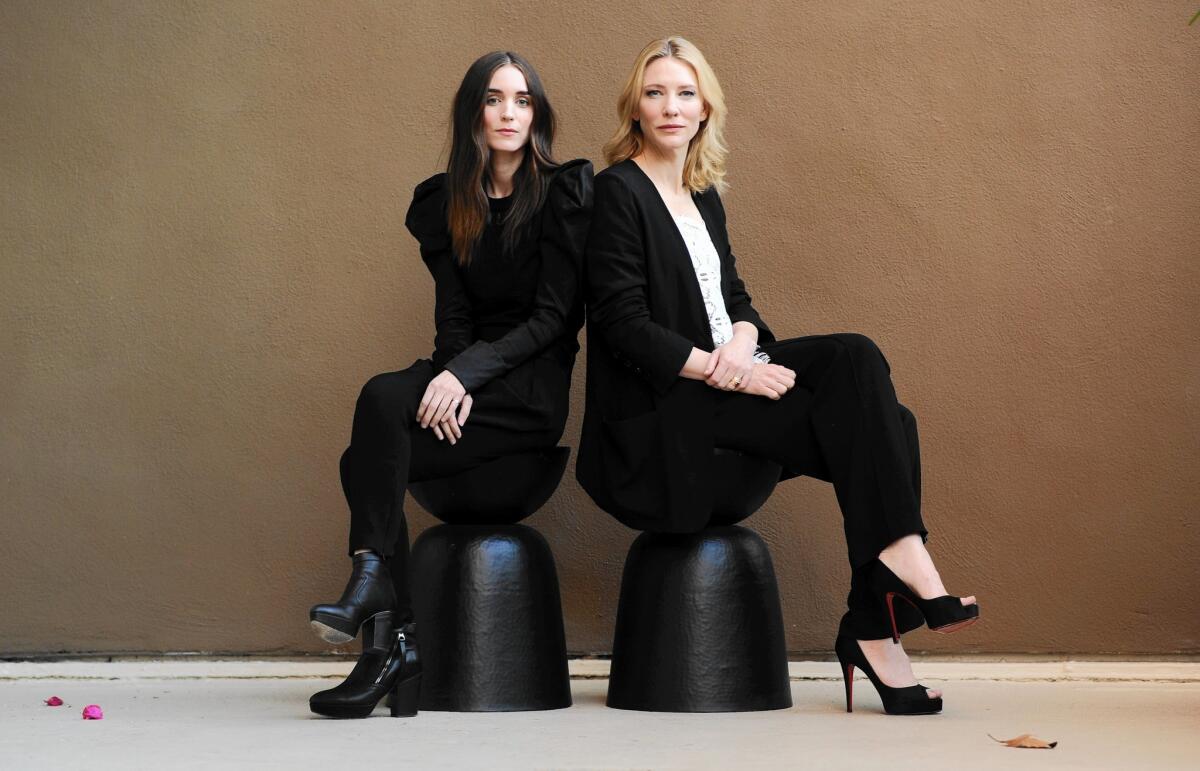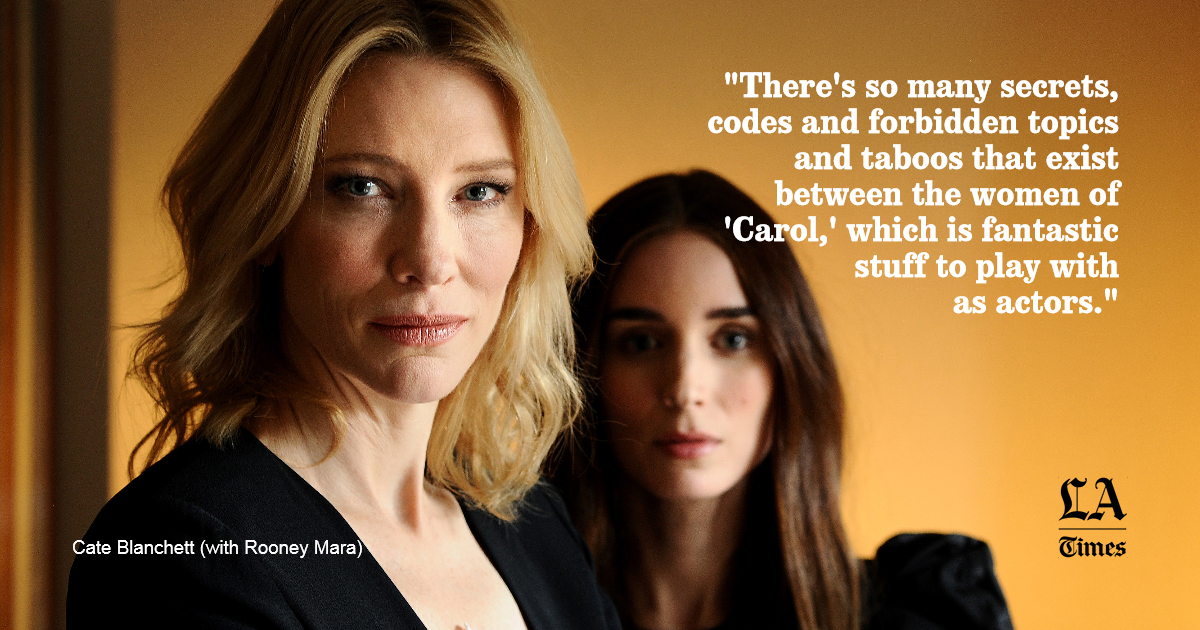Cate Blanchett, Rooney Mara faced ‘secrets ... forbidden topics ... taboos’ in the world of ‘Carol’

- Share via
In the period drama “Carol,” Cate Blanchett plays the elegant, sophisticated, title character who resides in the tony suburbs outside New York City. Rooney Mara portrays the shy young salesgirl Therese who works in a Manhattan department store.
The women have nothing in common until they fall in love, bending all social mores to bridge the gap between their worlds and that of the conservative society around them. Carol is trapped in what should be a perfect marriage. Therese, at least a decade younger than Carol, is headed toward the ideal life goal for a single girl in 1952 — marriage to her longtime fiance.
SIGN UP for the free Indie Focus movies newsletter >>
That stark contrast in style and deportment carried over into the real world recently when the actresses got together to discuss the film. Blanchett, dressed in a silky cream-colored pants suit and red stilettos, filled the room with her presence as she engaged on multiple levels about the subversive love story in the film. Mara preferred to speak as little as possible, looking like a somewhat disinterested teen in a gothy black outfit and pale, gloomy face makeup.
As for the age gap, Blanchett, 46, stepped out of the hotel press suite to call her kids. Mara, 30, tuned out those around her as she texted home to check on her dogs.
Equal to both actors, however, was the challenge of conveying the risk of a same-sex love affair to audiences who live in an age of marriage-equality legislation and transgender TV stars.
“There’s so many secrets, codes and forbidden topics and taboos that exist between the women of ‘Carol,’ which is fantastic stuff to play with as actors,” said Blanchett. “But here’s more to it than that. The same-sex nature of the relationship sits alongside the age gap, along the gulf of innocence as opposed to experience. There’s a lot of other textures in the film to explore beyond their relationship.”
“And both of the women are coming of age in a different way,” added Mara, who skyrocketed to fame for her blistering performance as the lead in David Fincher’s version of “The Girl With the Dragon Tattoo.” “They’re both at a stage of life where they have to decide what kind of women they’re going to be and if they’re going to live their truth or continue on in this life that doesn’t really feel like theirs.”

Cate Blanchett on “Carol”
“Carol,” out Friday in limited release, is the screen adaptation of Patricia Highsmith’s semi-autobiographical “The Price of Salt.” Highsmith, who also wrote “Strangers on a Train” and the “Ripley” series, published the book in 1952 under the pseudonym Claire Morgan because of its taboo subject matter. It wasn’t until five years before her death in 1995 that the author, who was a lesbian, put her own name on the book.
“The interesting thing about a Highsmith character is that they’re quintessential outsiders,” said Blanchett, who also costarred in 1999’s “The Talented Mr. Ripley.” “Going back over all her writing and filmmaking carnations, that outsider perspective was the thing I was interested in mining. The way she describes people who are morally, psychologically and socially sitting on the edges of society — and that fact that love is the crime here.”
Todd Haynes, whose 2002 romantic drama “Far From Heaven” broke similar boundaries by exploring homosexuality and race relations in the 1950s, debuted his new production at the Cannes Film Festival in May, where it received high praise and Mara was awarded the lead actress prize. Blanchett co-produced the film with British Number 9 Films, Film4 Productions and the New York-based Killer Films, and it is being distributed in the U.S. by the Weinstein Co.
Blanchett, a two-time Oscar winner, and Mara, nominated for “Dragon Tattoo,” are considered likely nominees this year.
The story of Carol was based on a real encounter Highsmith had working as a clerk in a department store. She did meet an older blond married woman who intrigued her, but the rest of the story — the flirting, the relationship – was part of Highsmith’s imagination about the fleeting encounter.
“Carol” screenwriter Phyllis Nagy met the author in the last decade of her life. Nagy was in her 20s when she connected with Highsmith while working as a researcher for the New York Times. Highsmith was living out her last years in Switzerland, and the two eventually began writing each other regularly.
“I’d get these fascinating letters from her about life and politics,” said Nagy. “She’d tell me which of her books to read and should not read. But she never mentioned this one until she published it under her own name and retitled it ‘Carol.’ She gave me a copy of the book and talked about it in such a personal way I was afraid to read it because, what if I had the wrong response? I expected it to be like all that lesbian pulp literature of the day, and it wasn’t. It had somewhat of a happy ending.”
Nagy, who’d become an accomplished playwright, was approached a couple of years after Highsmith’s death to do her first film adaptation with “Carol.” Though it was all but completed by 2000, it underwent a decade-plus of revision under various directors (including Stephen Frears and Kenneth Branagh) and investors until the project finally went cold. Nagy says the painful slog was a combination of the usual Hollywood shuffle of funding, rights and jitters over the accessibility of a film with two female leads. The other trepidation, of course, was dealing with gay themes.
“During its development, there was a very different kind of lesbian or gay movie that got financed,” said Nagy. “They were very agenda or issue driven, and this was not. In fact it insists on not being that in order to make the point. I would talk about that with financiers, and I could see them glaze over.”
When Blanchett is reminded of how long ago the initial adaptation was written for “Carol,” she was taken aback. “Oh, my God, were you even born yet?” she asked Mara.
Mara smiled, “I was, barely.”
Blanchett continued: “Normally when a screenplay sits around that long, by the time it hits the screen it feels a bit bruised and battered, compromised,” she said. “I’m thrilled it doesn’t feel like there were those creative compromises made in the process. It feels like it can only now be made.”
There’s a suffocating quality to the rooms and the environment the women are existing within.
— Cate Blanchett
The film, shot over six weeks in Cincinnati, is classic Haynes in that the story is told as much through the character’s emotions as the scenery (beautiful yet foreboding gray cold winter) and his depiction of the era (the uncluttered, postwar perfection of 1950s décor and society).
“There’s a suffocating quality to the rooms and the environment the women are existing within,” said Blanchett. “You could breathe that air in on the sets.”
Haynes prepared the actors with his own filtered view of artifacts from the era. “Todd sent us like five or six mix CDs from the time and this beautiful look book of all these photographs from the 1950s he felt represented what he wanted the film to look and feel like,” said Mara. “There’s a lot of different directions ‘Carol’ could have gone, but I could have never imagined the film Todd was going to make until I saw it. The film doesn’t feel like it’s preaching to the audience. It’s simply showing a reality and letting it live in the love story.”
Though the romance between the women is the driving theme here, an overt sentimentality is one thing you won’t find in “Carol.” True to Highsmith’s approach of never asking for sympathy for a character or situation, this sneakily powerful movie leaves it up to the audience to get there itself.
What would Highsmith have to say about this film? Likely nothing nice. She was renowned as a difficult personality. “Terse,” “rude” and “abrupt” were all used to describe the late author, a public persona that was perhaps a result of the impossible road she had to walk.
“Being a writer at any period in history is an uncomfortable relationship with the world, but she had a particularly difficult one,” said Blanchett. “The obsession and projection that she wrote about, the unspoken, the unshared psychology of her characters — it’s often dastardly the things we think in our heads.”
More to Read
Only good movies
Get the Indie Focus newsletter, Mark Olsen's weekly guide to the world of cinema.
You may occasionally receive promotional content from the Los Angeles Times.











